
Reductionism in Art and Brain Science
Bridging the Two Cultures
کتاب های مرتبط
- اطلاعات
- نقد و بررسی
- دیدگاه کاربران
نقد و بررسی

July 25, 2016
In this fascinating survey of mind science and modern art, Nobel laureate Kandel (The Age of Insight) focuses on reductionism as the principle guiding ongoing dialogue between the worlds of science and art. Whereas scientific reductionism “seeks to explain a complex phenomenon by examining one of its components on a more elementary, mechanistic level,” artists employ reductionism to enable viewers “to perceive an essential component of a work in isolation, be it form, line, color, or light.” According to Kandel, narrowing the focus of brain research to the components of learning and memory helps open up the ways that humans perceive art as well as the ways that humans evolve culturally to acquire insights into the nature of the world. Willem de Kooning (1904–1997), for example, reduced figuration because it enabled him to place emotional components into his paintings, and the absence of a figure helps viewers to perceive these emotions. Kandel concludes that abstract art allows people to experience it without reference to external knowledge, enabling viewers to participate in art by projecting their own impressions, feelings, and memories on the work. Kandel presents concepts to ponder that may open new avenues of art making and neuroscientific endeavor. Agency: Wylie Agency.

September 15, 2016
Reductionism is the breaking down of complex ideas or processes into smaller concepts. Nobel Prize-winning neuroscientist Kandel details how scientists used reductionist approaches to discover the basic mechanisms of perception. Specialized receptor cells in the eye and processing cells in the brain feed into our perception (bottom-up process) and interact with learning and experience (top-down processing) to construct our views of the world. Kandel argues that the groundbreaking artists of the mid-20th-century modernist New York School intuitively used the same strategy--breaking image creation into constituent parts--to pursue truth. Part human cognition primer and part art history, the book convincingly shows the parallels of the two divergent approaches to the world and points the way to a dialog between them. This title is fascinating and challenging. Kandel clearly loves modern art and does an excellent job with the art topics. His discussions on brain science are not as plainly rendered, however, and make the work less accessible to general readers. VERDICT Recommended for those interested in the intersection of psychology and art and who are already conversant in the former.--Nancy H. Fontaine, Norwich P.L., VT
Copyright 2016 Library Journal, LLC Used with permission.

























دیدگاه کاربران